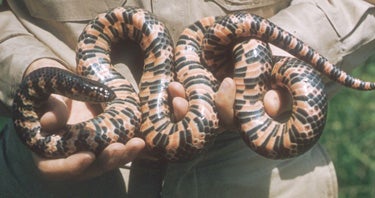SCIENTIFIC NAME:
Farancia abacura
Subspecies:
Farancia abacura abacura (Eastern) and Farancia abacura reinwardti (Western)
OTHER NAMES:
Hoop snake, horned snake, and stinging snake
STATUS:
Uncommon to fairly common throughout Coastal Plain, wherever suitable habitat is found. Also known from Interior Plateau near Tennessee River. Low Conservation Concern.
DESCRIPTION:
Mud snakes are large aquatic snakes that attain lengths up to 80 inches, but generally are 40 to 65 inches in length. The scales of the mud snake are smooth, with a glossy black color on the dorsal and a bright red or pink and black checkerboard pattern on the ventral. The mud snake has a sharp point on the end of its tail. The mud snake is very docile and refuses to bite, but its habit of pressing the spine-like tip of the tail against the captor’s skin gives rise to the misconception that the mud snake can sting. Thus, the common nicknames “horned snake” and “stinging snake.” Southern folklore also holds that the mud snake can take its tail in its mouth and roll like a wheel, giving rise to the common name “hoop snake.” However, this snake is not capable of moving in this manner. Mud snakes range throughout the coastal plain from east Texas to Virginia and up the Mississippi Valley to southern Illinois. In Alabama, the western subspecies is found in the western one-third of the Coastal Plain and the eastern subspecies in the eastern two-thirds, with a zone of integration between.
HABITAT:
Mud snakes inhabit swamps, marshes, ponds, and slow moving mud-bottom streams. They prefer aquatic areas with heavy vegetation, like beaver ponds with swampy margins.
FEEDING HABITS:
Adult mud snakes feed almost entirely on amphiumas and sirens. The presence and abundance of these chief components of the mud snake’s diet are required for mud snakes to survive. Juvenile mud snakes eat tadpoles, small salamanders, and fish.
LIFE HISTORY AND ECOLOGY:
Mud snakes are nocturnal, secretive, and the habitats they live in generally are not frequented by humans. They are rarely encountered for these reasons. The female mud snake lays 10 to 100 eggs in a cavity below ground near water in late summer. She may stay with the eggs until they hatch in eight to 12 weeks. Young mud snakes hatch in September or October and are brightly colored, six to seven inches long, and very active. Young mud snakes have many predators. Adult mud snakes are occasionally killed crossing roads, and cottonmouth snakes are known to eat adult mud snakes.
REFERENCES:
Mount, Robert H. 1975. The Reptiles & Amphibians of Alabama. Agricultural Experiment Station/Auburn University. pp. 188-190.
Conant, Roger and Joseph T. Collins. A Field Guide to Reptiles and Amphibians, Eastern and Central North America, The Peterson Field Guide Series, Third Edition. Houghton Mifflin Company. pp. 182
Nelson, S. Carson. Personal observations and field notes
Nelson, David K. Personal observations and field notes
Author:
Dave Nelson, Wildlife Biologist, Division of Wildlife and Freshwater Fisheries






